<iframe style="width:120px;height:240px;" marginwidth="0" marginheight="0" scrolling="no" frameborder="0" src="//ws-na.amazon-adsystem.com/widgets/q?ServiceVersion=20070822&OneJS=1&Operation=GetAdHtml&MarketPlace=US&source=ss&ref=as_ss_li_til&ad_type=product_link&tracking_id=peaceinvesting-20&language=en_US&marketplace=amazon®ion=US&placement=0060555661&asins=0060555661&linkId=80f8e3b229e4b6fdde8abb238ddd5f6e&show_border=true&link_opens_in_new_window=true"></iframe>|<iframe style="width:120px;height:240px;" marginwidth="0" marginheight="0" scrolling="no" frameborder="0" src="//ws-na.amazon-adsystem.com/widgets/q?ServiceVersion=20070822&OneJS=1&Operation=GetAdHtml&MarketPlace=US&source=ss&ref=as_ss_li_til&ad_type=product_link&tracking_id=peaceinvesting-20&language=en_US&marketplace=amazon®ion=US&placement=1119404509&asins=1119404509&linkId=0beba130446bb217ea2d9cfdcf3b846b&show_border=true&link_opens_in_new_window=true"></iframe>|<iframe style="width:120px;height:240px;" marginwidth="0" marginheight="0" scrolling="no" frameborder="0" src="//ws-na.amazon-adsystem.com/widgets/q?ServiceVersion=20070822&OneJS=1&Operation=GetAdHtml&MarketPlace=US&source=ss&ref=as_ss_li_til&ad_type=product_link&tracking_id=peaceinvesting-20&language=en_US&marketplace=amazon®ion=US&placement=1119376629&asins=1119376629&linkId=2f1e6ff64e783437104d091faaedfec7&show_border=true&link_opens_in_new_window=true"></iframe>

By Dr. Jim Dahle, WCI Founder
There are a lot of nice advantages of using exchange-traded funds (ETFs) over traditional mutual funds (MFs). However, one of the disadvantages is that you actually have to “trade” them. That is, you have to put in buy and sell orders in real time via a brokerage. Thanks to that newfangled internet, this is neither difficult nor expensive, but any increase in financial difficulty is likely to induce some investors to run to their nearest financial advisor and pay thousands a year rather than learn and implement a little bit of knowledge.
As people learn how to do this, one of the first questions that comes up is whether to use limit orders or “just” use a standard market order. At Vanguard, the order page looks like this:
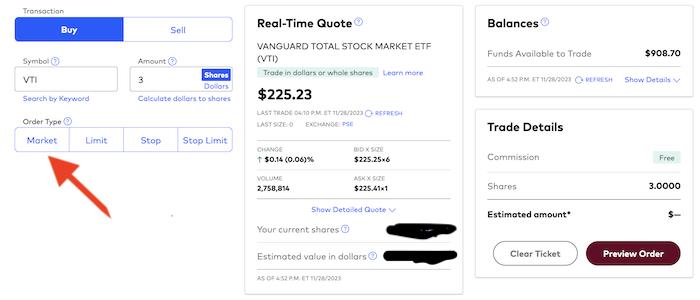
At Fidelity, it looks like this:
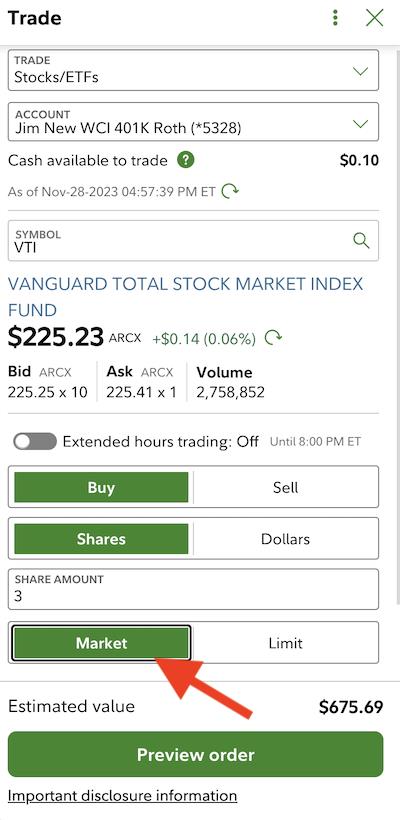
At Schwab, it looks like this:
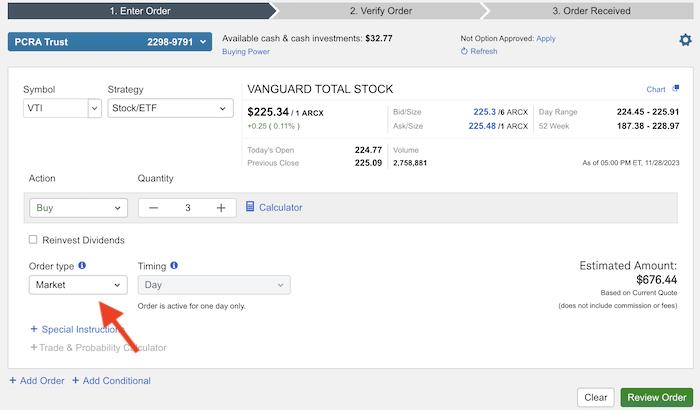
Other brokerages will look similar. But no matter where you go, you WILL have to select something for order type, usually market or limit.
What Is a Market Order?
A market order simply means that you get the current market price. It's like buying the fresh fish at the restaurant where the menu says “market price.” You put your order in, and you get what you get. The broker gets you the best price someone is willing to offer at that moment. The main benefit of a market order is that it happens right away. You can see where the market stands, and as long as your security is relatively liquid, you pretty much know the price you're going to get. When I put these orders in on the very liquid ETFs in my portfolio like VTI and VXUS, the trades always seem to happen instantaneously.
What Is a Limit Order?
A limit order is when you specify the minimum (if selling) or maximum (if buying) price at which you are willing to trade. The main benefit is that you know what price the trade will execute at before you enter the trade. The downside is that if the market does not get to that price, you may not get a trade at all.
More information here:
The Nuts and Bolts of Investing
What Are the Other Types of Orders?
You'll notice that some brokers offer other types of orders. In fact, Schwab's drop-down menu offers five different types of orders.
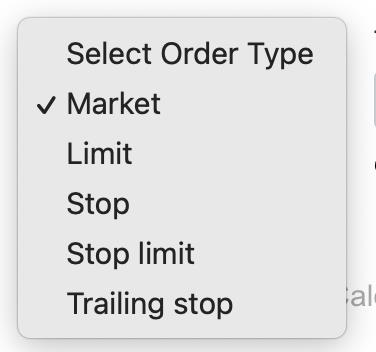
In addition to a market and a limit order, there is a stop order, a stop limit order, and a trailing stop order. A stop order, aka a stop loss order, is something employed by people who want to sell their security if it starts going down in price. It guarantees that if the market hits a certain price, the security will be sold. However, it does not guarantee the price at which it will be sold. You need a stop limit order for that. Think of a stop order as a market order triggered when the market hits a certain price and a stop limit order as a limit order triggered when the market hits a certain price. Basically, a stop order guarantees a transaction but not a price, and a stop limit order guarantees a price but not a transaction.
A trailing stop order follows the price up or down and transacts when the price changes direction. It can be set as a percentage or a dollar figure of the price. These three types of stop orders are typically used by traders—not long-term investors—in the hopes of capturing upside without giving up downside. The dangers occur when the market whipsaws, dropping and causing the investor to sell at their stop price and then rising higher than the price was originally.
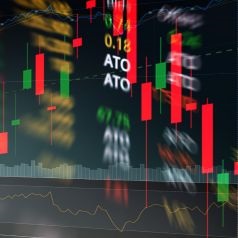
A stop order can cause some very strange effects with illiquid securities in highly volatile markets. For example, someone might put in a stop loss order at $35 a share for a security trading at $40 and then find when the market tanks hard one day that a sale has occurred at $28 because the market went so fast from $40 to $28 that there wasn't an opportunity to sell at $35.
More information here:
Do I Need to Spread My Assets Between Different Brokerages?
Restoring the Balance Between Savers and Borrowers
Why I Exclusively Use Market Orders
When I first started “trading” ETFs (mostly buying unless tax-loss harvesting), I used limit orders because I was worried for some reason that I'd get taken advantage of in the market. It turned out this was a non-issue, but the limit orders resulted in a lot of frustration. I'd put in a limit order to buy something at its current price, say $98.75, and then the price would quickly rise to $98.80, then $98.85, and then $98.90. I'd get frustrated, cancel the order, and put in a new order at $98.90 and then the price would rise to $98.95, and then $99 and I'd cancel the order again and put it back in. If I had just put a market order in, it would have executed at something between $98.75 and $98.80. In fact, if that first order had been $99, it would have also executed—not at $99 but at something between $98.75 and $98.80.
The securities I “trade” are extremely liquid. We're talking VTI, VXUS, VSS, VNQ, IXUS, ITOT, VNQ, AVUV, and DFSV. Even in volatile markets, I'm not getting hosed by putting in a market order. Instead, I get practically instantaneous execution and then I can move on to my next task rather than waiting around refreshing the order status to see what happened. If you're trading some thinly traded, little-known stock, you may feel a need to use limit orders, but I no longer do.
Need to get your own financial plan in place? Check out the Fire Your Financial Advisor course! It's a step-by-step guide to creating your own path to financial freedom. Try it risk-free today!
What do you think? Should market orders be the default order type for white coat investors? Why or why not? When do you use other order types? Comment below!
The post Should You Use a Market Order or a Limit Order When Trading? appeared first on The White Coat Investor - Investing & Personal Finance for Doctors.
||
----------------------------
By: The White Coat Investor
Title: Should You Use a Market Order or a Limit Order When Trading?
Sourced From: www.whitecoatinvestor.com/market-vs-limit-order/
Published Date: Sat, 25 May 2024 06:30:08 +0000
Read More
.png) InvestingStocksToolsClubsVideosPrivacy PolicyTerms And Conditions
InvestingStocksToolsClubsVideosPrivacy PolicyTerms And Conditions
